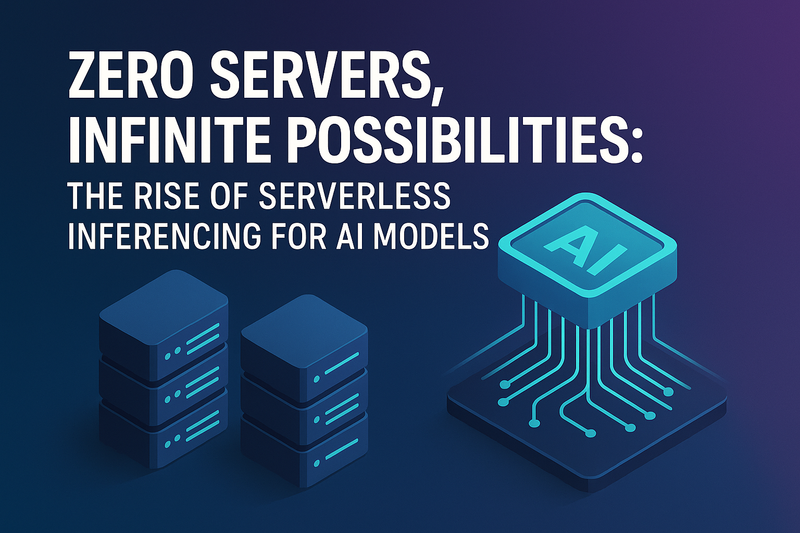Artificial intelligence (AI) has moved from labs to mainstream applications at lightning speed. But behind every intelligent chatbot, predictive model, and recommendation system lies a massive computational infrastructure—servers that process requests and return results in milliseconds. Yet, a new paradigm is changing the game: serverless inferencing.
This emerging approach promises to eliminate the complexity of managing servers while delivering scalable, cost-effective AI deployments. In simple terms, it’s about running AI models without worrying about the servers behind them. Let’s dive into what this means, why it matters, and how it’s shaping the future of AI.
What is Serverless Inferencing?
Serverless inferencing is a deployment model that allows developers to run AI models on demand, without provisioning or managing servers. It’s built on the principles of serverless computing, where infrastructure management is fully abstracted by a cloud provider.
Traditionally, when you deploy a machine learning model, it runs on a dedicated server or cluster—always on, consuming resources even when idle. Serverless inferencing, on the other hand, spins up resources only when a request comes in. Once the inference (prediction) is made, the resources automatically scale down.
This model works similarly to serverless functions (like AWS Lambda or Google Cloud Functions), but it’s optimized for the unique workloads of AI and machine learning.
Why Serverless Matters for AI
The most significant advantage of serverless inferencing is simplicity. AI teams can focus entirely on model performance and application logic, leaving infrastructure concerns behind. No more setting up Kubernetes clusters, managing GPU pools, or scaling pods manually.
But simplicity isn’t the only benefit. Here’s what makes it game-changing:
Cost Efficiency: You pay only for the actual inference time, not for idle servers.
Automatic Scaling: Whether you get one request or a million, the platform scales automatically.
Speed of Deployment: Developers can push models to production in minutes rather than days.
Global Reach: Many serverless platforms automatically replicate models across regions for low-latency inference.
For startups and smaller teams, this levels the playing field. They can deploy advanced AI capabilities without needing the deep pockets or DevOps teams of tech giants.
How Serverless Inferencing Works
Let’s break down the process in simple terms:
Model Upload: The data scientist uploads the trained AI model (say a transformer or CNN) to a serverless AI platform.
Endpoint Creation: The platform automatically generates an API endpoint.
On-Demand Execution: When an application sends a request to this endpoint, the platform spins up the necessary compute resources.
Inference: The model processes the input, returns the prediction, and releases resources immediately after use.
Under the hood, serverless inferencing uses containers or lightweight virtual environments to isolate requests. Technologies like AWS SageMaker Serverless Inference, Google Vertex AI, and Azure Machine Learning Serverless are leading the charge here.
The Benefits of Going Serverless for AI Models
- Cost Optimization
In traditional deployments, servers run continuously—consuming resources 24/7 even if requests are sporadic. Serverless inferencing eliminates this waste. You pay only for what you use, making it ideal for workloads with unpredictable or low traffic.
- Scalability Without Limits
Serverless platforms are built for dynamic scaling. Whether your app handles a few requests a day or spikes to millions during a viral event, the infrastructure automatically adjusts.
- Reduced Maintenance
With serverless, infrastructure management becomes the provider’s responsibility. Developers can skip the hassle of patching servers, managing load balancers, or dealing with downtime.
- Developer Productivity
By removing operational overhead, data scientists and engineers can focus more on innovation—improving models, testing new architectures, and delivering faster updates.
Challenges of Serverless Inferencing
Of course, no technology comes without trade-offs. While serverless inferencing is revolutionary, it also introduces challenges:
Cold Starts: Since compute resources spin up on demand, the first request may take longer to process.
Limited GPU Support: Not all serverless providers offer GPU acceleration yet, which can impact performance for large AI models.
Vendor Lock-In: Relying on a single cloud provider’s serverless infrastructure can reduce flexibility and portability.
Cost at Scale: For very high-throughput workloads, traditional always-on infrastructure might still be more economical.
Despite these hurdles, advancements in container cold-start optimization and multi-cloud solutions are quickly mitigating these issues.
Serverless Inferencing in Action
Many real-world applications are already benefiting from this model. Consider:
Chatbots and Conversational AI: Scaling NLP models without maintaining backend servers.
Image Recognition: On-demand image classification in apps like e-commerce and healthcare.
Personalization Engines: Real-time recommendations powered by machine learning models that activate only when needed.
IoT and Edge AI: Lightweight inferencing functions triggered by sensor data streams.
For instance, an e-commerce platform can use serverless inferencing to analyze user behavior in real time and personalize product recommendations—all while minimizing infrastructure costs.
The Future of Serverless AI
The rise of serverless inferencing marks a major evolution in AI deployment strategies. As AI models become more complex and widespread, organizations will prioritize efficiency, flexibility, and speed.
Emerging trends such as edge inferencing, multi-model orchestration, and hybrid deployments will further enhance this approach. Soon, developers won’t need to choose between performance and simplicity—they’ll have both.
In a way, serverless inferencing brings us closer to “AI as a utility”—accessible, elastic, and ubiquitous. Just as cloud computing democratized storage and compute, serverless is democratizing AI deployment.
Conclusion
Serverless inferencing is not just a buzzword—it’s a glimpse into the future of AI operations. It redefines how we build, scale, and deploy intelligent systems, making advanced AI accessible to anyone with a model and an idea.
In this new era of “zero servers, infinite possibilities,” developers can focus on innovation rather than infrastructure. The promise is clear: faster deployments, smarter scaling, and cost-effective AI that truly runs everywhere.
As organizations embrace this shift, the boundaries of what’s possible with AI will continue to expand—without the heavy burden of managing servers.
FAQs
What is the main advantage of serverless inferencing?
It allows AI models to run on demand without dedicated servers, reducing costs and complexity.Is serverless inferencing suitable for large models?
It depends on the platform. Some services now support GPU-accelerated serverless setups for heavy workloads.Can serverless AI work offline or on edge devices?
Edge inferencing combines local computation with serverless orchestration, offering hybrid flexibility.Which cloud providers offer serverless inferencing?
Major players include AWS SageMaker, Google Vertex AI, and Azure Machine Learning.Is serverless inferencing secure?
Yes, leading platforms ensure strong data isolation and encryption, though security best practices still apply.




Top comments (0)